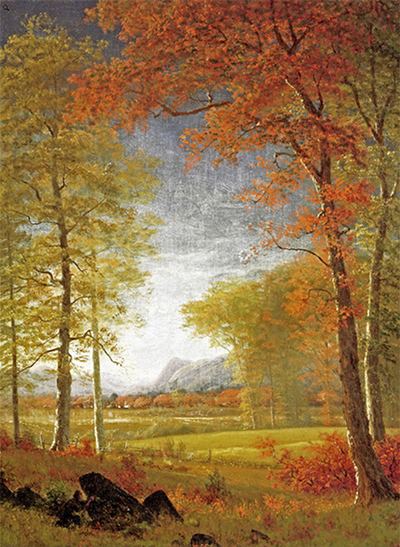The extraordinary quality of luminosity Albert Bierstadt achieved in his work is clearly apparent in this painting, whose full title is "Autumn in America, Oneida County, New York".
The rich and varied browns and golds of the autumn leaves capture and reflect the glow of the late afternoon sunshine. The composition, with trees framing a distant view, is calm and draws the eye into the distance. It may, however, not have been a painting of an actual location. It was common practice for artists at that time to create composite idealised scenes from their memory and their sketches. Bierstadt travelled widely and was both popular and commercially successful for many years, meeting Queen Victoria and receiving the Legion d'honneur from Napoleon III in 1867. Sadly, his enormous canvases and rather theatrical subjects lost favour towards the end of his life.
This painting, "Autumn in America" is currently in a private collection. Albert Bierstadt was born in Germany in 1831 and moved to the USA with his family a year later. Having returned to Germany for a period to study art, Bierstadt was awarded honorary membership of the National Academy of Design in New York after successfully exhibiting a Swiss landscape there in 1858. He began to travel in the American West with the government survey teams and was captivated by the spectacular scenery that he found there.
He drew and sketched, amassing materials that fuelled the production of huge paintings back in his New York studio. This painting is unusual, being considerably smaller than many of his works. He became known as a member of the Hudson River School, the name given to a group of painters whose work contrasted the peace and tranquillity of nature with the ruggedness of the wilderness and reflected the discoveries and explorations that characterised the advancing settlement of the 'wild' West. The Hudson River School painters frequently took inspiration from European painters like Constable and Turner.




